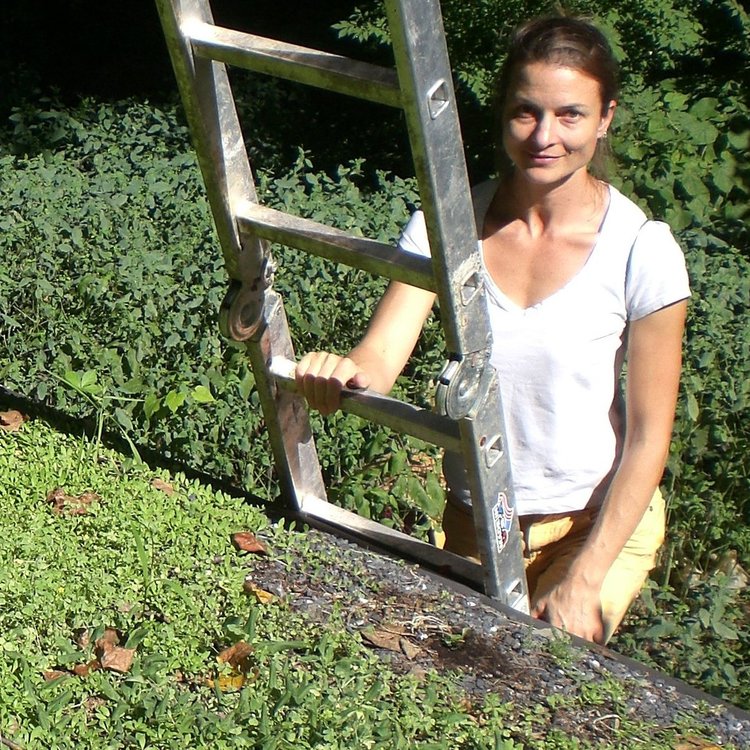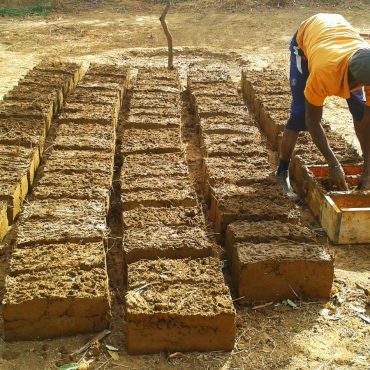
The Value of Poo: A short guide to composting toilets
Toilets and poop are always the uncomfortable and squeamish topics that we try to keep away from pleasant conversation, but are also two of the things we should really start […]


Here in the adolescent stages of the natural, building revival there are few architects or builders that have more than a handful of years of experience. Sigi Koko, owner and operator of Down to Earth Design, is one of the most established and prolific architect/builders of natural structures in the United States. Her company, founded in 1998, predominantly serves the mid-Atlantic region of the US and designs strawbale homes and residential-scale commercial structures for their environmentally minded clients. For almost twenty years now Sigi has been pushing the boundaries of the construction market towards sustainable and environmentally conscious building. She is also a major advocate and educator of natural building techniques, holding workshops and courses for students seeking to learn to build with natural materials. I had the privilege of interviewing her in July of 2016 to pick her brain for tips and advice for builders, and to get a window into her unique experience. To hear more from Sigi Koko you can also listen to the podcast interview with her.





Tell me a little about your background. What did you study and what did you do before natural building?
I grew up in Pennsylvania and did my undergrad at Bucknell University in both math and fine art (specializing in sculpture). I always knew I wanted to go into architecture and got the spectacular advice that I should take all the classes that interested me during undergrad, and only the ones that interested me, then go to grad school for architecture, so that’s what I did. It worked well because I have a wide range of interests. I think specializing your knowledge is bunk.
So then I went to graduate school for architecture at the University of Texas Austin and the course required that I do an apprenticeship for three years as part of the program. The thing is that I was being asked to tell all these builders what to do, but I was only taught to draw buildings, not make them. So before starting the apprenticeship I built houses for two years in Colorado to be better able to communicate and relate with builders. I learned that for everything you do, there’s more than one way to do it, and at least one way is a huge pain.
After that I did my apprenticeship at huge firm called HOK in Washington DC. The advantage of working with a big company was that they were doing some environmentally conscious projects even back when those were really rare, so I focused as much as I could on those projects. In the end I finished the apprenticeship in two years instead of three because I hated working in an office so much. Then I started my own business.
What got you interested in natural building?
Part of it was the way I grew up and my own personality. Our family was really eco conscious in the 70’s before anyone else I knew was. We recycled and reused things all the time so that just became the norm for me. I’m also a super pragmatic person so I don’t think it’s logical not to build naturally, plus to me it’s sexy.
In grad school I had a great professor who really got into the details, especially the physics of the natural buildings around the world and how they function. Rather than just lecturing about the existence of natural structures he went into why these material and techniques work. Most of my program had been about thermal mass buildings and so we got into how to insulate spaces and regulate temperature without added energy. We talked about different designs such as those in Spain that have open courtyards with a pool in the middle which channel air through the building and over the water, creating a cooling effect. I think any architectural program that doesn’t cover vernacular building from all over the world shouldn’t even be accredited. These techniques are essential to our history and are the precursors to the way we mostly build now.
How did you come to form your own company?
Well I’d always kept doing research on [natural building] techniques even while I was working at the firm in DC. Ever since I learned about adobe I was all in, then In school I got very excited about straw bales because they are insulative and can be built anywhere. I still do research all the time, just for fun. I knew I was just completing my apprenticeship to finish the program and check that box because there are still no options for natural building companies you can work for. I always knew I’d start my own company because it just clicked and I knew this was the only thing I wanted to do. I started the company right after finishing the apprenticeship.
What have been your biggest challenges since starting your own company?
By far, learning how to run a business. It has nothing to do with the natural building part, it’s about figuring out how to run a business that is profitable so you’re not just a charity. For five years I barely earned anything, which I justified in my head by saying “at least I’m doing what I love,” but this is not OK. I was living month to month and could never take a vacation. Finally, I hired a business coach and worked with them for two years. There was a profound difference. After that first year I added a zero to my annual income. Now I’m adamant not only about staying up with natural building knowledge but also staying informed about the business side.
What have been some of your most important projects? Most challenging? Most rewarding?
They’re all rewarding. Sincerely. I only work with clients that I know I’ll love working with. I always meet with them face to face before-hand and make sure that we’ll get along and have the same priorities from the get-go. Because of that I love every project. It’s a deal breaker for me if I don’t like who I work with.
As far as challenging jobs, commercial projects have a much larger set of moving parts especially with permits and contractors. In general, you’re upping the ante by taking them on. I don’t do any large commercial projects for that reason. I try to keep it all residential scale. Currently I’m working on a very challenging project that is requiring a lot of on-site work and has taken a lot longer on both the drawing and construction side. A big part of it is making sure that the builder doesn’t get overwhelmed. Normally my hands-on efforts at the build site are on the education side teaching the contractors how to put in straw bales and other natural elements.
These days I do all my exterior walls with straw bales. Sometime I’ll do parts with cordwood or slip straw, but mostly just strawbale buildings because good insulation is so critical here. For interior features I’ll do cob, rammed earth and adobe sometimes, and I love earthen floors.
What are some common misconceptions that many people have about natural building and strawbale construction in particular?
The number one misunderstanding is about the difference between insulation and thermal mass. Insulation slows the flow of energy from one side of the wall to the other and a thermal mass is an energy battery that stores heat or cold and releases it slowly. I see almost every day someone describing cob or rammed earth as insulative when those materials are strictly thermal mass.
The second most common misconception is that a natural home can be built for $5,000, or that it’s a much, much cheaper way to build. Maybe it’s possible to build an adequate house for yourself very cheaply if you only count the cost of materials but the truth is that, at the professional level, the cost of a natural home is the same as a conventional building. You exchange the cost for materials for the cost of labor. To me that idea is damaging because it puts people like me who make a living with this type of building on the defensive because people point to examples of homes that claim an absurdly cheap price and wonder why they should pay $20,000 to have their house re-plastered.
The third myth that needs to be corrected is the idea that you can’t build with straw bales in wet climates. Of course you can. A good way of thinking about it is that if you can build with wood you can build with straw. They are biologically identical. The only consideration is protecting the bales with a good plaster.
What advice would you give to someone who has just learned about the many options of natural building and wants to learn how to build for themselves?
I would say to experiment with something really little. Build a dog house, a chicken coop, or a shed. Use a lot of different natural materials and test them out. Get to know your climate too, even the little micro climates around your land like places that get more sun or have water features or hills. The main question to ask before deciding on your primary material is “do I use energy to change the temperature of the inside space?” If so, then your best bet will be to build a structure with an insulative exterior. Hybrid structures are using multiple materials can be a good option but think of it this way, you put a cold drink in a cooler, if the cooler is open it won’t stay cool very long. The same with having a straw bale house with a portion of the walls done in a thermal mass material. When it comes to passive solar design east, west, and north walls you’ll definitely want to insulate. The sun is hard to control and you don’t get any benefit from exterior thermal mass walls versus the heat dissipation that comes with them. On the south wall you can strategically calculate how much glass you put there and then put a thermal mass wall on the inside to absorb the solar gain. With that design you use the least amount of energy. That would represent the best practice for cold winter climates or places where you get four full seasons
What are some of the biggest pitfalls you’ve seen clients get into which could have been avoided? Same for builders.
The biggest ones for clients are communication issues with the builder, or choosing a builder who didn’t really want to do a natural building. At this point I don’t like to be responsible for choosing the builder. Now I just help clients screen for good contractors and talk to good builders who will be compatible with their priorities. Only twice in the last twenty years have I had builders who seem excited about a project but weren’t enthusiastic about it once they got into it. They either just wanted something unusual to put in their portfolio or were desperate for the work. As it turns out, this type of building requires patience because there is a learning curve. In the worst case scenario the builders can screw something up, and sometimes they could just leave because they didn’t know what they’d gotten themselves into.
On the flip side, a sad truth for the builders is that they’re are often treated very poorly by architects. As an architect myself, showing respect for the contractor is paramount. I don’t want them to be reluctant to ask questions or interact and give feedback to me. I make sure that I meet face to face with all the contractors I work with before we even start to show them that I’m looking to work with them and collaborate, and that we have a shared interest.
What resources would you point people towards if they want to learn more about what you do and natural building in general?
For inspiration go to naturalhomes.org it’s a great site that shows possibilities and examples of natural buildings from all over the world. One book I would recommend would be “Building Green” is a really comprehensive how-to resource. For a second book “The Natural Building Companion” has lots of practical information as an overview of all main types of natural building materials.
Where and how do you see the world of natural building growing in the upcoming years?
I think the shift so far has been toward the fact that more of the general population now knows that natural building exists and that didn’t used to be the case. There is better awareness in general. My starting point now is assuming that everyone has heard of a straw bale building. The next shift that I see happening now, often with coders and regulators, which is where it should start, is an understanding that natural materials are viable, suitable and appropriate to use.
This credibility is also helping to create wider adoption from the building community because often times builders are reluctant to adopt new materials and methods because they are used to working with what they know and want to remain in that comfortable zone. If that mindset doesn’t change, natural building wont become ubiquitous.
Where I see the change happening first for the general public is with natural finishes and remodels, things like adobe floors, clay plasters, natural paints, and insulation with clay straw. People are starting to consider options that they wouldn’t have before. Retrofits always come first as the pathway to broader acceptance. I think this area will grow a lot faster than the specialty custom homes and in turn then lead to using natural materials for those larger projects.
To hear more from Sigi Koko, check out the podcast interview that I did with her here.
Please note that the answers above have been paraphrased to keep them concise and are not direct quotes. To learn more about Sigi and her work you can visit her company site, blog, and youtube channel.
Tagged as: natural builder, Articles.

Toilets and poop are always the uncomfortable and squeamish topics that we try to keep away from pleasant conversation, but are also two of the things we should really start […]



Copyright Regenerative Skills 2021
Post comments
This post currently has no comments.